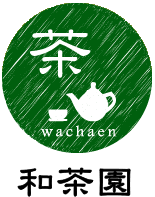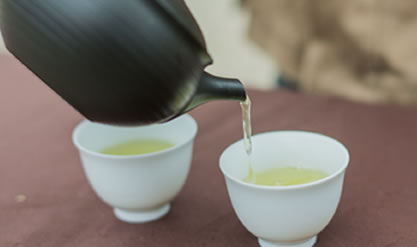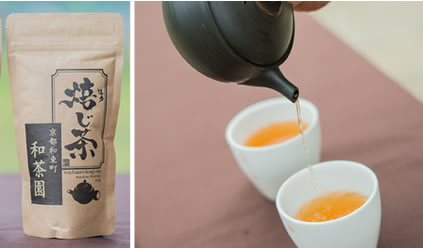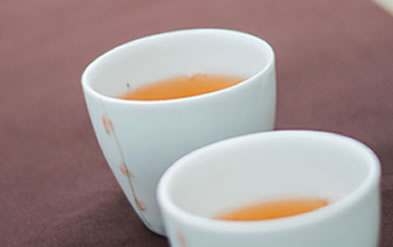
Way to be a tea farmer
I, Wachaen's representative, Osamu Ueda, was originally born in Hirakata City in Osaka and grew up in an urban area. When I was a child, I longed for a life like "Heidi, a girl in the Alps" (a famous TV show in Japan). I just adored the image of the life of a peaceful dairy farmer. Before I decided to become a tea farmer, I participated in an internship at a ranch in Hokkaido while I was in high school. After becoming an adult, I spent about a year on a working holiday in New Zealand. Through the years, I had come to know Wazuka and some people there, and I couldn’t stop thinking about tea farming. I was determined to become a tea farmer in Wazuka. Then I studied tea farming at a school specialized for tea for two years, completed three years of apprenticeship, and started my own tea farm as "Wachaen".

During the apprenticeship, I traveled from Hirakata to the fields every day and stayed in town during the harvest period to learn how to make tea.
Not only making tea
By fate, I visited Wazuka Town and was fascinated by the people of Wazuka. I am truly grateful to many local people supporting me to be a tea farmer. I have been thinking about expressing my appreciation in my way. In recent years, in order to let people in urban areas know the real scenes of Wazuka tea making, we accept farm work experience, accept foreigners for farm stay (about 1 week to 1 month), participate in various events, local festivals and so on. We also plan and introduce more programs such as rural experience programs. People who visit Wazuka for the first time are very impressed by the scenery of the tea fields like "Wow! It's so beautiful!”, and when they look at the actual tea plantation deep in the mountains, they are like “Seriously, you can't see down this steep slope, can you?” By seeing their amazed faces, I really feel that it is fun to deliver excitement other than just making tea in Wazuka. I would like many people to see the actual fields and have a true “wow” experience.

To pass the baton to new farmers
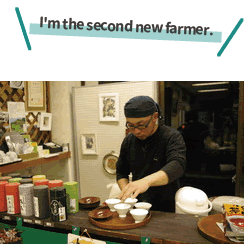 I am the second new farmer from outside the town. There are many young successors in Wazuka Town, but there are really few "non-local" farmers from outside the town. I have seen several people give up because they cannot overcome various hurdles. I have been able to make tea so far with the support of many people. I also want to do my best as a person in a position to support others little by little, not just being supported. I would like to pass on my experiences including overcoming various hurdles, as a baton to new farmers. I'm sure there are many people who have interests and dreams about farming. At first, I didn't feel that farming would become such a big part of my life. This job is affected by natural disasters and the weather. Every year I do my best to make even better tea reviewing the nature and cultivation. Since 2013, the trend of aging has been rushing to Wazuka Town at a rapid pace year by year, and the number of farmers who have given up their tea fields has increased. That is why I would like to wholeheartedly support those who want to start farming, pass on this important baton, to protect and inherit the tea plantations.
I am the second new farmer from outside the town. There are many young successors in Wazuka Town, but there are really few "non-local" farmers from outside the town. I have seen several people give up because they cannot overcome various hurdles. I have been able to make tea so far with the support of many people. I also want to do my best as a person in a position to support others little by little, not just being supported. I would like to pass on my experiences including overcoming various hurdles, as a baton to new farmers. I'm sure there are many people who have interests and dreams about farming. At first, I didn't feel that farming would become such a big part of my life. This job is affected by natural disasters and the weather. Every year I do my best to make even better tea reviewing the nature and cultivation. Since 2013, the trend of aging has been rushing to Wazuka Town at a rapid pace year by year, and the number of farmers who have given up their tea fields has increased. That is why I would like to wholeheartedly support those who want to start farming, pass on this important baton, to protect and inherit the tea plantations.
Tea making by putting our heart into one bud and one leaf
Many of the tea plantations of Wachaen are located deep in the mountains on steep slopes. The steep slopes deep in the mountains are very important for making fragrant tea. There is a large temperature difference between day and night, and fog rises in the morning and evening which covers daylight. The exquisite conditions that can only be created in nature, such as steep slopes, produce truly fragrant and delicious tea. At the same time, we value the preservation and cultivation of native cultivars that have been handed down from the Kamakura period about 800 years ago. Native cultivars known as Zairai are the tea plants grown from the tea seeds that are native to the area. They have particularly prominent natural tea aromas which have unique natural aroma that cannot be created by human efforts. The cultivation method can change the taste of the tea, but it cannot create the aroma of the tea. In addition, we work on cultivation methods that allow tea plants to grow as naturally as possible without stress. For example, sencha cultivation does not involve shading (covering tea plants with cloth to block sunlight). In order for tea trees to grow strong with healthy thick branches, we prune thin and weak branches even before the first harvest, which is the most important time for tea cultivation. Our commitment is to utilize the power of the natural topography, the original aroma of tea, and the original power of the tea plant to the fullest extent to the very end of tea plants, one bud and one leaf.

Left) one bud and one leaf
Right)
Instructor of the hand-rolled tea preservation society: hand-rolling tea every year for the first tea market of the year in Kyoto
Awards and medias
3rd prize at the 64th Kansai Tea Competition
Certified instructor of National Hand-rolling Tea Promotion Association
Wazuka Town Certified Farmer, Certified Person of the Sixth Industry Plan of Ministry of Agriculture, Forestry and Fisheries
Declaration of new farmers http://karusyoku.com/sinkisyunou/sinkisyunou_01.html
Kyoto Prefecture Social Business “Kyoto Chibiz” http://chiibiz.com/interview/%e5%92%8c%e8%8c%b6%e5%9c%92/
Shipping directly from the farm with simple packaging
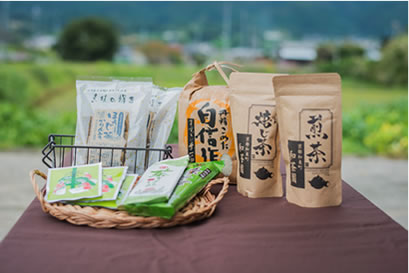 Wachaen strives to use simple wrapping and packing, and ships from the post office.
Wachaen strives to use simple wrapping and packing, and ships from the post office.
Please note that the products are mainly for commercial and home use, we do not offer individual wrapping services, and outer box for shipping may be recycled cardboard.。
One bud and one leaf in gratitude for relationship
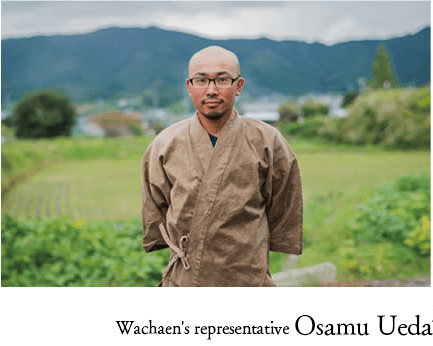 Since I visited Wazuka Town as a volunteer 11 years ago, I had a longing for farmers and the tea industry, went to school for tea agriculture for 2 years, completed 3 years of intern work and became independent. I received help and advice from many people in Wazuka and tea farmers until I was able to rent a field and manage the production. Since I decided to become a Wazuka resident, I have been able to continue producing tea every year thanks to many connections and favors that have led me to this day. There are still only a few new farmers in Wazuka Town, so I hope that I can pass on the warm help I have received to the next generation and the next new farmers. In order to improve the quality of tea year by year, we will continue to make efforts every day so that we can make tea with the perfection of the tea that will be proven at the leaf tip "one bud and one leaf". Thank you for reading the Wachaen story.
Since I visited Wazuka Town as a volunteer 11 years ago, I had a longing for farmers and the tea industry, went to school for tea agriculture for 2 years, completed 3 years of intern work and became independent. I received help and advice from many people in Wazuka and tea farmers until I was able to rent a field and manage the production. Since I decided to become a Wazuka resident, I have been able to continue producing tea every year thanks to many connections and favors that have led me to this day. There are still only a few new farmers in Wazuka Town, so I hope that I can pass on the warm help I have received to the next generation and the next new farmers. In order to improve the quality of tea year by year, we will continue to make efforts every day so that we can make tea with the perfection of the tea that will be proven at the leaf tip "one bud and one leaf". Thank you for reading the Wachaen story.

● Sencha ● Hojicha ● Wakocha ● Matcha
 Tea town that began 800 years ago. Wazuka sencha
Tea town that began 800 years ago. Wazuka sencha
Many of the Wachaen tea plantations are located on steep slopes deep in the mountains. The steep slopes deep in the mountains are very important for making fragrant tea. There is a big difference in temperature between day and night, fog is formed in the morning and evening, and the sunlight is shortened. These exquisite natural conditions produce fragrant tea.

Wachaen’s sencha
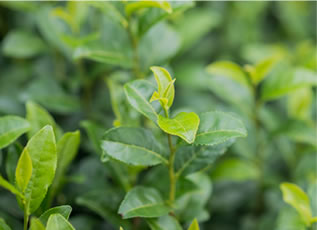 We value the preservation and cultivation of native cultivars that have been handed down from the Kamakura period about 800 years ago. Native cultivars as known as Zairai are the tea plants grown from the tea seeds that are native to the area. They have particularly prominent natural tea aromas which have unique natural aroma that cannot be created by human efforts. The cultivation method can change the taste of the tea, but it cannot create the aroma of the tea. We also work on cultivation methods that allow tea plants to grow as naturally as possible without stress. For example, sencha cultivation does not involve shading (covering tea plants with cloth to block sunlight). In order for tea trees to grow strong with healthy thick branches, we prune thin and weak branches even before the first harvest, which is the most important time for tea cultivation.
We value the preservation and cultivation of native cultivars that have been handed down from the Kamakura period about 800 years ago. Native cultivars as known as Zairai are the tea plants grown from the tea seeds that are native to the area. They have particularly prominent natural tea aromas which have unique natural aroma that cannot be created by human efforts. The cultivation method can change the taste of the tea, but it cannot create the aroma of the tea. We also work on cultivation methods that allow tea plants to grow as naturally as possible without stress. For example, sencha cultivation does not involve shading (covering tea plants with cloth to block sunlight). In order for tea trees to grow strong with healthy thick branches, we prune thin and weak branches even before the first harvest, which is the most important time for tea cultivation.
Harvest at the best time for the tea leaves
Tea leaves are generally harvested on the eighty-eighth day from the first day of spring of the lunar calendar, but at Wachaen, we check the movement of the sun and the growth of the tea on a daily basis before deciding on the tea processing process.
Usually in the market, the earlier the shipping date is, the higher the price of the tea. I think it is important to ascertain the best timing for each tea field for customer satisfaction rather than the market price.
 We handle wholesale to restaurants and retailers who understand our commitment and passion. Please feel free to contact us using the inquiry form below.
We handle wholesale to restaurants and retailers who understand our commitment and passion. Please feel free to contact us using the inquiry form below.
 Hojicha, roasted green tea - carefully roasted, very drinkable
Hojicha, roasted green tea - carefully roasted, very drinkable
The tea field for Hojicha of Wachaen is weeded by hand, fertilized, and processed then carefully roasted. The scent when you open the seal is exceptional. We produce two types of roasted green tea: "Bancha Hoji", which has a refreshing flavor, and "Sencha Hoji", which is roasted green tea with a strong flavor. Please try them if you like a sweet aroma.
 Good for kids
Good for kids
Green tea contains caffeine. Small children can try hojicha first, which has less caffeine due to roasting. Hojicha is also recommended for pregnant women. Caffeine is extracted at a high temperature, so cold brew hojicha or hojicha brewed at about 70°C will have even less caffeine.
How to brew hojicha
 We handle wholesale for restaurants and retailers who understand our commitment and love for tea. Please feel free to contact us from the form below.
We handle wholesale for restaurants and retailers who understand our commitment and love for tea. Please feel free to contact us from the form below.
 Wakocha, Japanese black tea ? Sweet without sugar
Wakocha, Japanese black tea ? Sweet without sugar
Since there are less than 10 black tea farmers in Wazuka, black tea from Wazuka is not produced in large numbers. Green tea leaves are aged and fermented then slowly processed to become black tea. It is less astringent than normal black tea, so you can enjoy it without sugar. We recommend to drink it as a straight tea for the first brew, and add honey or milk for the second brew.
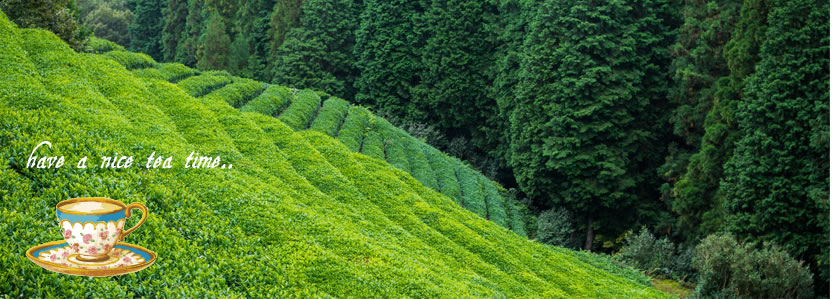
Less astringent than normal black tea
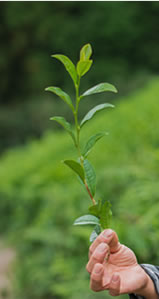 In general, the weather in Japan is milder for tea trees than other black tea countries with little temperature difference between day and night, which gives Wakocha a gentle and slightly sweet taste.
In general, the weather in Japan is milder for tea trees than other black tea countries with little temperature difference between day and night, which gives Wakocha a gentle and slightly sweet taste.
Many people think that black tea is only suitable for cakes and cookies, but Wakocha, which was nurtured in the climate of Japan, goes well with Japanese sweets and Japanese cuisine as well.
Black tea has a long history in Japan, and during the post-war period it was actively produced in Japan and exported. However, it declined due to the liberalization of black tea imports (1971).
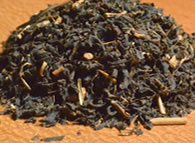 At Wachaen, inheriting the techniques and methods that have existed from the old days, we proceed with production adding our own fermentation technique. We can still only process a small amount, but we hope you will enjoy rare Wazuka Wakocha.
At Wachaen, inheriting the techniques and methods that have existed from the old days, we proceed with production adding our own fermentation technique. We can still only process a small amount, but we hope you will enjoy rare Wazuka Wakocha.
Enjoy a sweeter tea time with cold brew Wakocha
Wakocha can be brewed in a pot for a cup of hot tea, and in the summer, cold brew is also recommended. Add about 10-15g of tea leaves to 1 liter of water and let it rest for 6 hours.
Caffeine and catechins, which are the source of astringency, are difficult to extract in cold temperature, so the tea has a sweeter taste than hot tea.
You can enjoy tea time all year round by changing how you drink it in winter and summer.
 We handle wholesale to restaurants and retailers who understand our commitment and passion. Please feel free to contact us anytime.
We handle wholesale to restaurants and retailers who understand our commitment and passion. Please feel free to contact us anytime.
Maximizing the natural sweetness of tea
Theanine, the component for sweetness is retained by controlling photosynthesis.
Matcha is made by processing the tea leaves into tencha and grinding it.

Tencha is harvested and processed in a state in which the leaves are shaded from light to suppress photosynthesis and retain as much of the sweet component as possible in the leaves.
At the tencha factory, the harvested leaves are steamed and slowly dried in a high-temperature oven stacking the leaves one by one without overlapping.

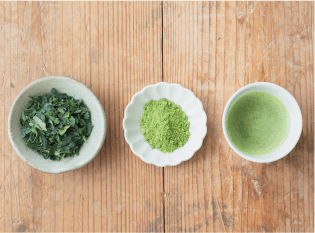 The process in a tencha oven adds the aroma to the tea.
The process in a tencha oven adds the aroma to the tea.
By allowing the finished tencha to rest for a while, the sharp flavor is removed, the depth of flavor is increased, and the sweetness and astringency become well-balanced.
Matcha is made by grinding tencha into fine particles over time.
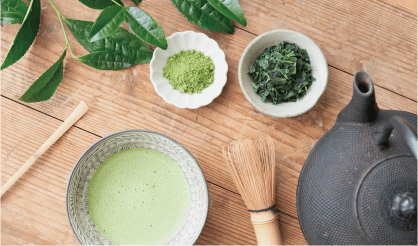 Also, Matcha is the best way to take in the nutrients of tea, as the grounded tea leaves are completely consumed.
Also, Matcha is the best way to take in the nutrients of tea, as the grounded tea leaves are completely consumed.
We hope you will fully enjoy the aroma, sweetness and nutrients of matcha.
Copyright © wachaen. website produce by yoridono-web.



